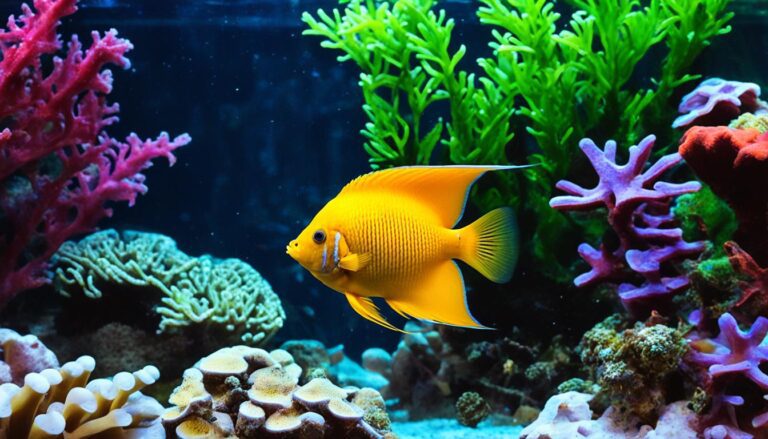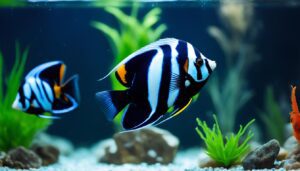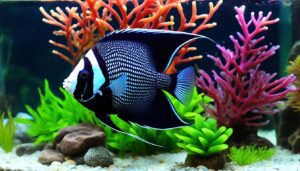Welcome to the bright world of Golden Angelfish, a true treasure among freshwater angelfish species. As a keen hobbyist, I’m excited to guide you through the enchanting world of aquarium Golden Angelfish. For both experienced and new aquarists, knowing how to care for Golden Angelfish is key. These beautiful fish, known for their elegance, are from the Amazon Basin. They thrive in calm streams there.
I’ve spent many hours with these magnificent fish and can’t wait to share what I know about breeding Golden Angelfish and angelfish maintenance. Reaching the stunning metallic glow of an adult Golden Angelfish shows the care you’ve given. These beauties can reach 6 inches in size and live for 10 to 12 years, adding beauty and companionship to your tank.
A Natural Portrait: Origins and Habitat of Golden Angelfish

Exploring the aquarium trade reveals the colorful world of the Amazon Basin Golden Angelfish. These fish originate from South America’s vast ecosystems, especially the Amazon Basin. In their natural environment, they experience a life far different from our home aquariums.
The Amazon Basin: Exploring their Wild Environment
The Amazon Basin is where Golden Angelfish call home. It stretches across countries like Brazil and Peru. These regions provide dense vegetation and warm, acidic waters, perfect for the angelfish. In the wild, they avoid predators and flourish in a biologically rich setting.
Observing them in their natural habitat lets us see their complex behaviors and social structures. These can be hard to mimic in captivity.
Understanding the Impact of Sunlight on Color and Health
Sunlight is crucial for Amazon Basin Golden Angelfish. It affects their health and stunning colors. In the wild, natural light and the water make their yellows and golds shine. Sunlight helps angelfish look vibrant and indicates they’re living in a stress-free setting.
This makes it clear that proper sunlight is key to having bright and active fish. It shows they are healthy and well.
Knowing where golden angelfish come from and their habitat helps aquarists care for them better. We learn about the balance needed to keep them in aquariums. This gives us a deeper understanding of these beautiful creatures.
Identifying Golden Angelfish: Patterns and Colors
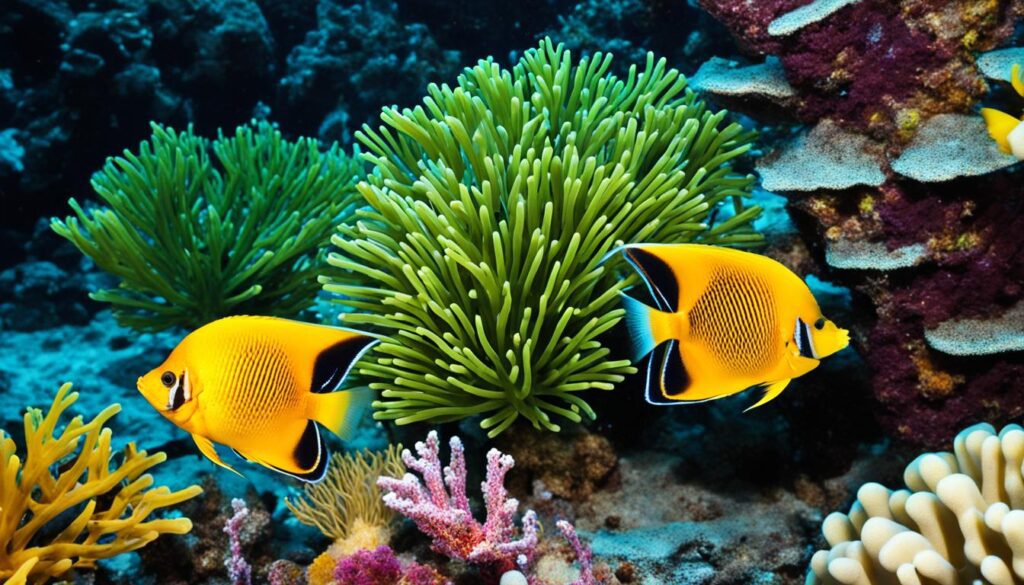
Learning about Golden Angelfish identification is fascinating for both enthusiasts and aquarists. Golden Angelfish come in vibrant angelfish colors and intricate angelfish patterns. These features vary depending on the breed and their environment.
Keen on identifying these majestic creatures? Golden Angelfish colors range from deep gold to orange and yellow mixes. Their colors change with mood and health, showing their well-being.
Some breeds have unique patterns aiding in identification. Marbled ones lack black stripes, showing off black, white, and gold. Also, Albinos are striking in pure white, and Panda angelfish display a stunning white and black contrast.
Angelfish Type |
Distinctive Colors |
Patterns |
Typical Size |
|---|---|---|---|
Marble Angelfish |
Gold patches on white |
Marbled |
Up to 6 inches |
Koi Angelfish |
Varying orange on the head |
None |
Up to 6 inches |
Black Lace Angelfish |
Dark body |
Lace-patterned fins |
Up to 6 inches |
Blushing Angelfish |
Translucent with red gills |
None |
Up to 6 inches |
Half-Black Angelfish |
Black caudal part, may have gold marbling |
Marbling/Blushing |
Up to 6 inches |
Understanding these patterns and colors is key for Golden Angelfish identification. It also helps in knowing the health and breed of your angelfish. Appreciating angelfish colors and angelfish patterns makes caring for these pets more rewarding. Next time, take a close look at your aquarium. You might find something new and wonderful about your fish!
Creating a Thriving Home: Tank Setup and Requirements
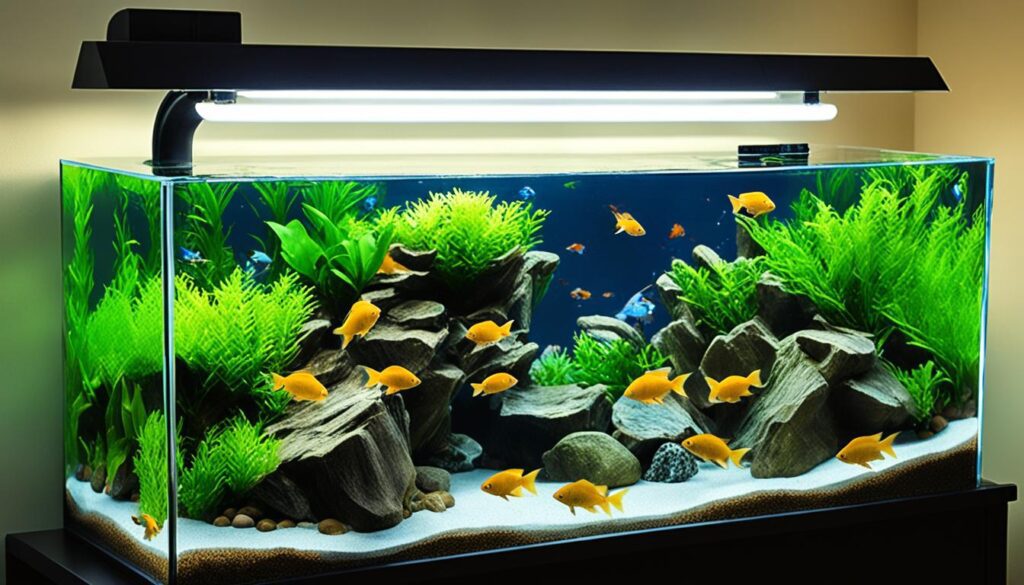
Starting an Amazon-inspired aquarium for angelfish begins with planning the angelfish tank setup. These fish do well in settings like their Amazonian home, so it’s important to get the conditions right. This helps them stay healthy and live longer.
To make the tank feel like the Amazon, focus on angelfish aquascaping and choosing the right appropriate aquarium plants. Use fine sand for the substrate to create a natural and comfortable environment. Adding plants like Amazon sword or Java fern offers beauty. They also provide shade and hiding spots for the shy angelfish.
Replicating the Amazon: Tank Conditions for Success
For angelfish to thrive, keep the tank warm, between 78-86°F. Watch the water’s pH levels and hardness closely. They should be below 6.5 for pH and 3-8 dKH for hardness. This prevents diseases like Ich and fin rot.
For more info on the best living conditions for angelfish, check out this detailed angelfish care guide.
Choosing the Right Flora: Plant Selection for Angelfish Tanks
Choose Amazon-native plants like anacharis to beautify and balance the tank, making it perfect for angelfish. These plants do well in soft, acidic water, just like their home. You can also add moss for texture and depth.
By setting up the right environment and choosing suitable plants, you keep angelfish healthy. It turns your aquarium into a lively, Amazonian scene. This approach ensures a thriving underwater ecosystem in your home.
Golden Angelfish Care and Feeding for Vitality and Growth
If you love Golden Angelfish like I do, you’ll enjoy learning how to keep them healthy and vibrant. A good diet is key for their energy and growth, especially for Golden Angelfish. They eat a lot of different things in the wild, like insects, larvae, and tiny shellfish. In your tank, it’s crucial to give them the right mix of foods. This will help them stay happy and healthy in your care.
Balanced Diet: What to Feed Your Golden Angelfish
Feeding your Golden Angelfish the right way is critical for their health. They do best on a diet rich in protein, enjoying live food such as tubifex worms and brine shrimp. Adding fish flakes and some plant foods will also help. This keeps them healthy and their colors bright.
Routine Matters: Frequency and Amount of Feeding
How often and how much you feed your Golden Angelfish matters a lot. Feed adult fish twice a day with enough food they can eat in two minutes. This avoids overfeeding and keeps your tank clean. For young fish, a mix of live baby brine shrimp and quality prepared foods helps them grow. Stick to these feeding tips for a diet that keeps your Golden Angelfish thriving.
